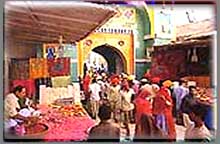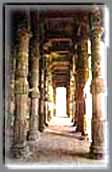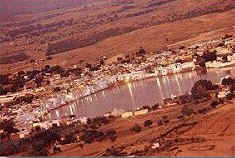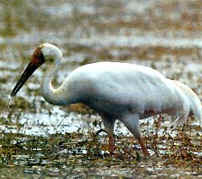| Rajasthan
| Jaipur | Ajmer
| Alwar | Bikaner
| Bharatpur | Deeg
| Jodhpur| Jaisalmer
| Kota | Pushkar |
Ranthambore | Wildlife
|
Hotels and Resorts
| Shekhawati

TOURIST SPOTS IN
RAJASTHAN Ajmer
:- This city is
as old as turbulent history. It is linked to Delhi, Agra, Ahamedabad, Mount Abu,
Jodhpur, Udaipur and Jaipur through main highways. It was the capital along
with Delhi of Chauhan'era. After the defeat of Prithvi Raj Chauhan at the
hand of Mohd. Ghori(1193), it rendered to many invasion and gory battles. It is a
great center of pilgrimage for Hindus and Muslims that gives a genuine amalgam.  In the
heart of city, is the dargah of KHWAJA MOIN-ud-DIN
CHISTI, `DARGAH SHARIF'-probably the most important Muslim Shrine in the
India-Sub-Continent with tens of thousands of pilgrims flocking
here especially during the URS celebrations. it is the
second Mecca/Madena, for the South Asian Muslims. In the
heart of city, is the dargah of KHWAJA MOIN-ud-DIN
CHISTI, `DARGAH SHARIF'-probably the most important Muslim Shrine in the
India-Sub-Continent with tens of thousands of pilgrims flocking
here especially during the URS celebrations. it is the
second Mecca/Madena, for the South Asian Muslims.
Adhai-Din-Ka-Jhonpra
:-
 These are ruins situated on the
outskirts of the town. Legend says that the construction of this mosque took 21/2
days in 1153. Originally, this was the Sanskrit College
but, this was demolished by Mohd. Ghori along with the other temples and built a mosque.
Pillars from at least thirty temples, must have gone into
the making of this elegant monument. A great example of
Indo-Islamic architecture. These are ruins situated on the
outskirts of the town. Legend says that the construction of this mosque took 21/2
days in 1153. Originally, this was the Sanskrit College
but, this was demolished by Mohd. Ghori along with the other temples and built a mosque.
Pillars from at least thirty temples, must have gone into
the making of this elegant monument. A great example of
Indo-Islamic architecture. Taragarh : It is a fort 3 kms from the dargah and command a superb view over
the city. Top Daulat Bagh : A park on the banks of Ana Sagar having a series of marble pavilions erected
in 1637 by Shah Jahan. Pushkar  This small township and the sacred lake of Pushkar is II kms.
away from Ajmer. The road to Pushkar winds through the Nag Pahar (Snake
Mountain), leading to the ancient lake. According to religious texts this lake
is supposed to have appeared miraculously when a lotus flower fell from the
hands of Lord Brahma and dropped into this valley. This small township and the sacred lake of Pushkar is II kms.
away from Ajmer. The road to Pushkar winds through the Nag Pahar (Snake
Mountain), leading to the ancient lake. According to religious texts this lake
is supposed to have appeared miraculously when a lotus flower fell from the
hands of Lord Brahma and dropped into this valley.
Pushkar lake, believed by the Hindus to be as old as creation,
has been a place of pilgrimage through the centuries. Pushkar has stood witness
to the procession of history from the time of Rama, the hero of the earliest
Hindu epic the Ramayana, to Fa-Hien's accounts of Pushkar in the 4th century
A.D. and to the time of the Muslim invasions. There are 52 bathing ghats, built around the lake. The water
around each ghat is supposed to have special powers. The Naga Kund is believed
to give fertility, Roop Tirth beauty, Kapil Vyapi Kund water helps in curing
leprosy and a dip in the Mnkand Muni Kund grant the boon of wisdom.

Annually on Kartik Pumima (the full moon day), the famous
Pushkar fair is held. Devotees come to take a holy dip in the lake water. Folk
dancers and folk musicians of different regions and culture come together to
breathe new life into the town. Famous for it's camel fair which is held every
year in November.
Top Ranthambore
National Park  Ranthambore
National Park is one of the best examples of the efforts in Project Tiger. It is
located between Bharatpur and Kota near Sawai Madhopur. In the last census 27
tigers were counted. this park which provides a wonderful scenery is spread in
the vast area of 400 sq. kms has a lot of lakes and rivers flowing through. On
top of one of the inclined surfaces there is a well preserved Ranthambore Fort
which was built in 10th century. A lot of ruins of pavilions, canopies can be
found here. These were used by the maharajas for hunting. Ranthambore
National Park is one of the best examples of the efforts in Project Tiger. It is
located between Bharatpur and Kota near Sawai Madhopur. In the last census 27
tigers were counted. this park which provides a wonderful scenery is spread in
the vast area of 400 sq. kms has a lot of lakes and rivers flowing through. On
top of one of the inclined surfaces there is a well preserved Ranthambore Fort
which was built in 10th century. A lot of ruins of pavilions, canopies can be
found here. These were used by the maharajas for hunting.
Top KOTA Kota is situated on the
eastern banks of river Chambal. City Palace and Fort
: This is one of the largest
of complexes in the whole of Rajasthan. Top Rao Madho Singh
Museum : Weapons, old
costumes, stuffed beasts and very well preserved murals are the hallmark of this
museum which is situated inside the city palace. Jagmandir : Constructed in 1346 lies
the picturesque artificial tank, Kishore Sagar. In the middle of this tank, on a
small island is the enchanting small palace of Jagmandir which was constructed
in 1740 by a Maharani of Kota. Brij Vilas Palace
Museum : It is near Kishore Sagar
and has a collection of Stone idols and other fragments. These are mainly from
the archeological sites at Baroli and Jhalawar. Chambal Gardens and
Chatar Bilas Gardens : Considered as good Picnic
spots. Chambal gardens are famous for a pond which is full of crocodiles and
gharials. While Chatar Bilas has a collection of impressive and royal
cenotaphs. Shah-Jahan's
Mosque : This is the most beautiful of all the structure, in the Dargah Precinct. it is made of white marble, delicately
carved with trellis-work. Top 
Kuchaman
Fort ALWAR Emerging in the 18th
century it is one of the first Rajput States to make friends with the British
Empire. Bala Qila : This fort has five
kilometers of ramparts and stands 300 mts above the city. This fort can only be
visited by special permission. The palace complex below the fort has huge gates
and tanks and a chain of ghats and pavilions. Top BHARATPUR  Bharatpur
is famous for it's Bird Sanctuary, the Keoladeo Ghanna National Park, which is
Heritage-listed. October to February is when many migratory birds can be seen
here. There are at least 415 kinds of birds which have been recorded here. Out
of this 117 migrate from Siberia and China. Apart from being a wildlife rich
city Bharatpur is also famous for it's Lohagarh Fort, which is said to be an
18th century fort and occupies the entire small artificial island in the center
of the town. There are three palaces which are in decayed stage of which houses
a museum whose exhibits include sculptures, paintings, weapons and animal
trophies. Bharatpur
is famous for it's Bird Sanctuary, the Keoladeo Ghanna National Park, which is
Heritage-listed. October to February is when many migratory birds can be seen
here. There are at least 415 kinds of birds which have been recorded here. Out
of this 117 migrate from Siberia and China. Apart from being a wildlife rich
city Bharatpur is also famous for it's Lohagarh Fort, which is said to be an
18th century fort and occupies the entire small artificial island in the center
of the town. There are three palaces which are in decayed stage of which houses
a museum whose exhibits include sculptures, paintings, weapons and animal
trophies.
Top DEEG The ancient town of Deeg is located
34 kms. form Bharatpur. It finds mention in Skanda Purana as Dirgha of
Dirghapura. The place is now known for its famous palaces, gardens and
fountains. The famous old fortress of Deeg, which contributed substantially in
the making of the Jat principality, is now in shambles. Its formidable cannons
now lie abandoned in the forlorn fort.
 Deeg was the first capital of
the newly carved out Jat state, when Badan Singh was proclaimed its ruler in
1722. The royal palace, built by Badan Singh, on the southern side of the garden
is now called as Purana Mahal or the old palace. Deeg, because of its strategic
location and proximity to Mathura and Agra was vulnerable to repeated attacks by
invaders. In 1730, the Crown Prince Surajmal is reported to have erected the
strong fortress with towering walls, bastions, a deep moat and high ramparts
about 20 feet wide, in the southern portion of the town.
Although Surajmal shifted his capital to Bharatpur,
his liking for Deeg did not diminish. He built elegant Bhawans clustered around
a garden complex, with fountains in the front and enormous water bodies in the
rear. The entire complex of places and gardens is marvel of engineering skill.
The elegance of design and perfection of workmanship of these palaces is not
seen elsewhere in India. The palaces form a quadrangle, in the centre of which
is a garden, an oblong space of 145 meters by 107 meters, laid out with flower
beds and fountains.
To the east and west are large masonry tanks, with another garden on the other
side of the western tank beyond the buildings, forming the quadrangle. The
building to the north is called the Nand Bhawan. The main building on the west
is called Gopal Bhawan and is the largest of all palaces. On either side of the
Gopal Bhawan are two smaller buildings, called the Sawan and Bhadon Bhawans.
These building including the Gopal Bhawan command a view of the western tank and
gardens beyond it. These three palaces, although single storey in the front,
have in addition two more floors at the back. One of the storeys of these places
is either partially or wholly submerged in water throughout the year.
On the southern side of the quadrangle are two places facing north. One of them,
Suraj Bhawan, is built entirely of marble and is tastefully ornamented with
stones of different colors. The other palace, built of grey sandstone, is called
the Kishan Bhawan. One the roof of this place is a large water reservoir (41 mts
x 32 mts. X 2 mts.) which feeds the fountains spread all over the garden. The
reservoir was filled with water from two large wells. The engineering skill of
this roof to hold such an enormous quantity of water has no parallel any where.
James Fergussion in his History of Indian and Eastern Architecture says that the
Deeg palaces have been built on a perfectly level plan and laid out with a
regularity that would satisfy the most fastidious renaissance architect. The
places lack the massive character of the fortified places of Rajput State but in
grandeur of conception and beauty of details, they surpass them all.
These bhawans are built along the four sides of a garden. The Jat rulers of Deeg
and Bharatpur were influenced by the grandeur of the Mughal courts of Agra and
Delhi. They were keen on making their palaces better or at least equal to them.
They brought all items like gates, stone slabs, beams, etc from Mughal areas and
used them in the construction or decoration of the places. A fine marble swing
was brought here as a war trophy by Raja Surajmal from the Mughal court of
Delhi. Similarly, the black marble throne installed in front of Gopal bhawan is
a trophy brought by Maharaja Jawahar Singh, who in 1764 A.D., secured it on his
victory over Delhi.
This small town has
massive fortifications and stunning palaces. The Maharaja Suraj Mahal's second
capital also has an entire marble building which is his booty after he attacked
the Red Fort in Delhi. The
Suraj Mahal's Palace (Gopal Bhawan), is one of India's most
beautiful and proportioned buildings. The Maharajas were using
it until the early 1970's, so the original furnishings can still
be seen here. Top
Rajasthan
| Jaipur | Ajmer
| Alwar | Bikaner
| Bharatpur | Deeg
| Jodhpur| Jaisalmer
| Kota | Pushkar
| Ranthambore | Wildlife
|
Hotels and Resorts
| Shekhawati
|



